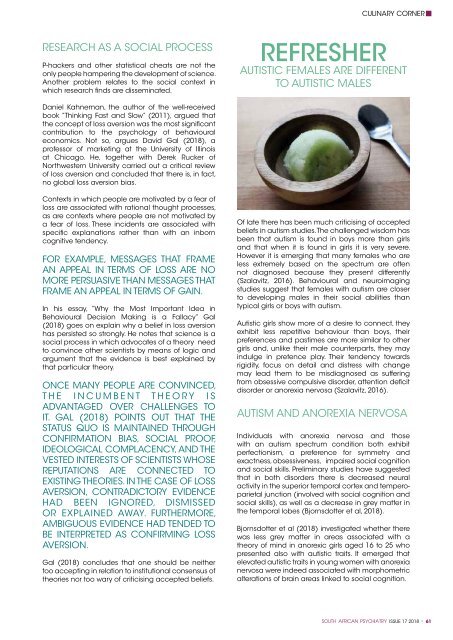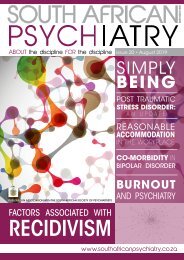South African Psychiatry - November 2018
South African Psychiatry - November 2018
South African Psychiatry - November 2018
Create successful ePaper yourself
Turn your PDF publications into a flip-book with our unique Google optimized e-Paper software.
CULINARY CORNER<br />
RESEARCH AS A SOCIAL PROCESS<br />
P-hackers and other statistical cheats are not the<br />
only people hampering the development of science.<br />
Another problem relates to the social context in<br />
which research finds are disseminated.<br />
REFRESHER<br />
AUTISTIC FEMALES ARE DIFFERENT<br />
TO AUTISTIC MALES<br />
Daniel Kahneman, the author of the well-received<br />
book “Thinking Fast and Slow” (2011), argued that<br />
the concept of loss aversion was the most significant<br />
contribution to the psychology of behavioural<br />
economics. Not so, argues David Gal (<strong>2018</strong>), a<br />
professor of marketing at the University of Illinois<br />
at Chicago. He, together with Derek Rucker of<br />
Northwestern University carried out a critical review<br />
of loss aversion and concluded that there is, in fact,<br />
no global loss aversion bias.<br />
Contexts in which people are motivated by a fear of<br />
loss are associated with rational thought processes,<br />
as are contexts where people are not motivated by<br />
a fear of loss. These incidents are associated with<br />
specific explanations rather than with an inborn<br />
cognitive tendency.<br />
FOR EXAMPLE, MESSAGES THAT FRAME<br />
AN APPEAL IN TERMS OF LOSS ARE NO<br />
MORE PERSUASIVE THAN MESSAGES THAT<br />
FRAME AN APPEAL IN TERMS OF GAIN.<br />
In his essay, “Why the Most Important Idea in<br />
Behavioural Decision Making is a Fallacy” Gal<br />
(<strong>2018</strong>) goes on explain why a belief in loss aversion<br />
has persisted so strongly. He notes that science is a<br />
social process in which advocates of a theory need<br />
to convince other scientists by means of logic and<br />
argument that the evidence is best explained by<br />
that particular theory.<br />
ONCE MANY PEOPLE ARE CONVINCED,<br />
THE INCUMBENT THEORY IS<br />
ADVANTAGED OVER CHALLENGES TO<br />
IT. GAL (<strong>2018</strong>) POINTS OUT THAT THE<br />
STATUS QUO IS MAINTAINED THROUGH<br />
CONFIRMATION BIAS, SOCIAL PROOF,<br />
IDEOLOGICAL COMPLACENCY, AND THE<br />
VESTED INTERESTS OF SCIENTISTS WHOSE<br />
REPUTATIONS ARE CONNECTED TO<br />
EXISTING THEORIES. IN THE CASE OF LOSS<br />
AVERSION, CONTRADICTORY EVIDENCE<br />
HAD BEEN IGNORED, DISMISSED<br />
OR EXPLAINED AWAY. FURTHERMORE,<br />
AMBIGUOUS EVIDENCE HAD TENDED TO<br />
BE INTERPRETED AS CONFIRMING LOSS<br />
AVERSION.<br />
Gal (<strong>2018</strong>) concludes that one should be neither<br />
too accepting in relation to institutional consensus of<br />
theories nor too wary of criticising accepted beliefs.<br />
Of late there has been much criticising of accepted<br />
beliefs in autism studies. The challenged wisdom has<br />
been that autism is found in boys more than girls<br />
and that when it is found in girls it is very severe.<br />
However it is emerging that many females who are<br />
less extremely based on the spectrum are often<br />
not diagnosed because they present differently<br />
(Szalavitz, 2016). Behavioural and neuroimaging<br />
studies suggest that females with autism are closer<br />
to developing males in their social abilities than<br />
typical girls or boys with autism.<br />
Autistic girls show more of a desire to connect, they<br />
exhibit less repetitive behaviour than boys, their<br />
preferences and pastimes are more similar to other<br />
girls and, unlike their male counterparts, they may<br />
indulge in pretence play. Their tendency towards<br />
rigidity, focus on detail and distress with change<br />
may lead them to be misdiagnosed as suffering<br />
from obsessive compulsive disorder, attention deficit<br />
disorder or anorexia nervosa (Szalavitz, 2016).<br />
AUTISM AND ANOREXIA NERVOSA<br />
Individuals with anorexia nervosa and those<br />
with an autism spectrum condition both exhibit<br />
perfectionism, a preference for symmetry and<br />
exactness, obsessiveness, impaired social cognition<br />
and social skills. Preliminary studies have suggested<br />
that in both disorders there is decreased neural<br />
activity in the superior temporal cortex and temperoparietal<br />
junction (involved with social cognition and<br />
social skills), as well as a decrease in grey matter in<br />
the temporal lobes (Bjornsdotter et al, <strong>2018</strong>).<br />
Bjornsdotter et al (<strong>2018</strong>) investigated whether there<br />
was less grey matter in areas associated with a<br />
theory of mind in anorexic girls aged 16 to 25 who<br />
presented also with autistic traits. It emerged that<br />
elevated autistic traits in young women with anorexia<br />
nervosa were indeed associated with morphometric<br />
alterations of brain areas linked to social cognition.<br />
SOUTH AFRICAN PSYCHIATRY ISSUE 17 <strong>2018</strong> * 61

















